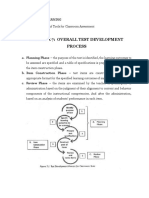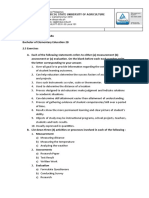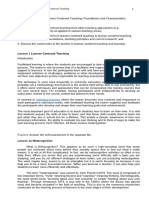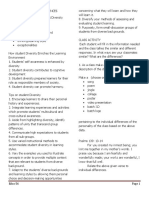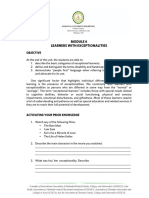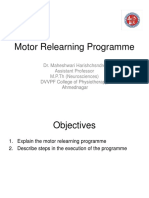Module 19
Uploaded by
Somaya BasareModule 19
Uploaded by
Somaya BasareCPE104-Ff
Module 19: Meaning and Types of Motivation
Motivation
is a process whereby goal-directed activity is instigated and sustained. (Schunk, Pintrich, &
Meece, 2008.
An inner drive to do something and persevere at something. While ability refers to what
children can do, Motivation refers what these children will do. We persist working on that same
thing through thick and thin until its completion.
Indicators of a High Level of Motivation
Your students level of motivation is shown in his/her choice of action, intensity, persistence of
effort.
A Highly Motivated Student is:
Excited about learning and accomplishing things.
Takes initiative without being pushed by his/her teachers and parents.
He/She has goals to accomplish and dreams to realize.
Convinced that accomplishing the things he/she is asked to accomplish in class will help
him/her realize the goals she has set for himself/herself to achieve his/her dreams in
life.
Willing to give up temporary satisfaction for a long-term and more important goals.
Doesn't give up easily
Learns much more than the one who isn't as motivated.
He/She persists and perseveres in his/her studies even when things turns out to be
difficult.
A Student who isn't Motivated to Learn
Does not enjoy learning.
Does not study unless "pushed".
When faced with difficult times he/she easily gives up.
He/She lacks perseverance.
In, summary motivated students:
have positive attitudes toward school and describe school as satisfying.
persist on difficult tasks and cause few management problems.
process information in depth and excel in classroom learning expertise.
(Stipek, 1996, 2002 cited by Wooltok, 2013)
Two types of motivation:
CPE104-Ff
1. Intrinsic motivation - When the source of motivation is from within the person
himself/herself or the activity itself.
It is motivation to engage in an activity for its own sake. (Schunk et al, 2008).
Example: Sam is a 6th grade pupil and excels academically in class. He carry out his
task just because he likes and enjoys what he is doing.
2. Extrinsic motivation - Motivation is extrinsic when that which motivates a person is
someone or something outside him/her.
Example: May is a 5th grade pupil and excels academically in class. She is motivated to
obtain high grades.
The role of extrinsic motivation
Extrinsic Motivation is necessary to develop the love for learning among poorly
motivated students.
External Motivation in the form of rewards, incentives or punishment.
It is expected, however that this extrinsic motivational factors be gradually replaced by
internal motivation.
Hopefully the students will develop the genuine love for learning in the process.
We may begin employing extrinsic motivation at the start but this should fade away as
the students get intrinsically motivated themselves.
Prepared by:
Basare, Somaya B.
Sumaguina, Cadidja T.
You might also like
- Facilitating Learning - Module 2 - Learner Centered Psychological Principles (LCP)No ratings yetFacilitating Learning - Module 2 - Learner Centered Psychological Principles (LCP)10 pages
- Docto Claud BEEd 3 Special Topics and Teaching Multi GradeNo ratings yetDocto Claud BEEd 3 Special Topics and Teaching Multi Grade20 pages
- This Study Resource Was: Facilitating Learner-Centered Teaching '100% (1)This Study Resource Was: Facilitating Learner-Centered Teaching '3 pages
- Chapter 7: Overall Test Development ProcessNo ratings yetChapter 7: Overall Test Development Process25 pages
- EDUC 100 Cognitive Development of PreschoolersNo ratings yetEDUC 100 Cognitive Development of Preschoolers11 pages
- Multicultural Diversity: A Challenge To Global Teachers"No ratings yetMulticultural Diversity: A Challenge To Global Teachers"1 page
- 139-148, ProfEd 323 (Technology For Teaching and Learning 1), Rota, Chester Kent Clarence A100% (1)139-148, ProfEd 323 (Technology For Teaching and Learning 1), Rota, Chester Kent Clarence A19 pages
- Facilitating Learning PROF - ED 306: Behaviorism: Pavlov, Thordike, Skinner100% (1)Facilitating Learning PROF - ED 306: Behaviorism: Pavlov, Thordike, Skinner9 pages
- ASSURE: An Instructional Design Model: A-S - S - U - R - ENo ratings yetASSURE: An Instructional Design Model: A-S - S - U - R - E5 pages
- Choose A Topic in Your Field of Specialization0% (2)Choose A Topic in Your Field of Specialization1 page
- Ethel B. Refuerzo - Facilitating in Human LearningNo ratings yetEthel B. Refuerzo - Facilitating in Human Learning33 pages
- Almira Abad Btled 2-A Merry Grace Abella Btled 2-A: PreambleNo ratings yetAlmira Abad Btled 2-A Merry Grace Abella Btled 2-A: Preamble5 pages
- Part 3 - Module 14 Constructivism Knowledge Construction Concept LearningNo ratings yetPart 3 - Module 14 Constructivism Knowledge Construction Concept Learning12 pages
- PCK120 Module 1 Facilitating Learner Centered TeachingNo ratings yetPCK120 Module 1 Facilitating Learner Centered Teaching14 pages
- Module 3 Review of Theories Related To The Learner's DevelopementNo ratings yetModule 3 Review of Theories Related To The Learner's Developement75 pages
- Chapter 9 - THE SCHOOL HEAD IN SCHOOL-BASED MANAGEMENT (SBM)No ratings yetChapter 9 - THE SCHOOL HEAD IN SCHOOL-BASED MANAGEMENT (SBM)22 pages
- Cognitive Development of The: High School LearnersNo ratings yetCognitive Development of The: High School Learners20 pages
- Teaching in Multiple Intelligence Classrooms100% (1)Teaching in Multiple Intelligence Classrooms19 pages
- Module - Unit 6 - Facilitating - Learner - Centered TeachingNo ratings yetModule - Unit 6 - Facilitating - Learner - Centered Teaching6 pages
- Bandura'S Social Learning Theory AND Tolman'S Purposive BehaviorismNo ratings yetBandura'S Social Learning Theory AND Tolman'S Purposive Behaviorism2 pages
- Facilitating Learner Centered Teaching Module 19 26No ratings yetFacilitating Learner Centered Teaching Module 19 2672 pages
- Management by Objectives: Dr. Gnanasekar Thirugnanam Assistant Professor Department of Hospital AdministrationNo ratings yetManagement by Objectives: Dr. Gnanasekar Thirugnanam Assistant Professor Department of Hospital Administration20 pages
- Science 7 1st Quiz 1 Science Process SkillsNo ratings yetScience 7 1st Quiz 1 Science Process Skills2 pages
- How To Write A Story For B1 Preliminary (PET) WritingNo ratings yetHow To Write A Story For B1 Preliminary (PET) Writing20 pages
- SMK Tengku Idris Shah, 42200 Kapar Rancangan Pengajaran Dan Pembelajaran Tahunan English Language Form 3 2016 / PBS Band LVL Gramma RNo ratings yetSMK Tengku Idris Shah, 42200 Kapar Rancangan Pengajaran Dan Pembelajaran Tahunan English Language Form 3 2016 / PBS Band LVL Gramma R10 pages
- Problems in Translating Collocations in Religious Texts From Arabic Into EnglishNo ratings yetProblems in Translating Collocations in Religious Texts From Arabic Into English37 pages
- Motor Relearning Programme: Dr. Maheshwari Harishchsndre Assistant Professor M.P.TH (Neurosciences)No ratings yetMotor Relearning Programme: Dr. Maheshwari Harishchsndre Assistant Professor M.P.TH (Neurosciences)26 pages
- (Studies in The History of The Language Sciences 23) Fred W. Householder - The Syntax of Apollonius Dyscolus-John Benjamins Publishing Company (1981)100% (1)(Studies in The History of The Language Sciences 23) Fred W. Householder - The Syntax of Apollonius Dyscolus-John Benjamins Publishing Company (1981)288 pages
- Eigenfaces Vs Fisher Faces PresentationNo ratings yetEigenfaces Vs Fisher Faces Presentation28 pages
- Lesson 4 Develop Career and Life DecisionsNo ratings yetLesson 4 Develop Career and Life Decisions22 pages
- Roles Creative Thinking and Problem Solving EngNo ratings yetRoles Creative Thinking and Problem Solving Eng2 pages

















